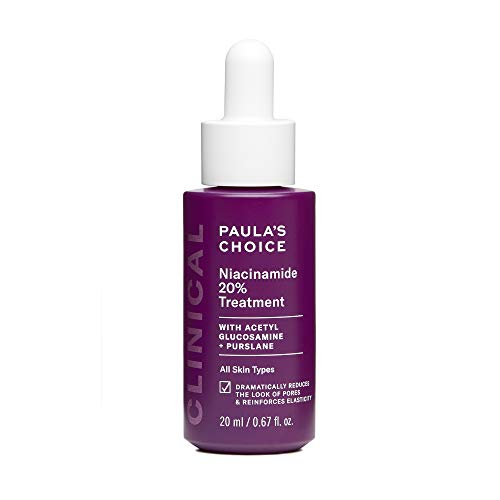Trust Me, It's Time to Start Using Niacinamide—Your Skin Texture Will Thank You
The multi-tasking ingredient works for everyone.


As a beauty writer, I’ve spent more time with skin-care ingredients than I have with most people, and niacinamide ranks high on the list. Pronounced "nye-uh-sin-uh-mide" (in case you’ve been wondering), this INCI list staple shows up everywhere: moisturizers, serums, cleansers, face masks—you name it. And its popularity isn’t just about a fancy-sounding name; the benefits are genuinely hard to beat.
What sets niacinamide apart from other ingredients is that it’s a multitasker in every sense of the word. “Think of it as the quiet overachiever in your routine,” says board-certified cosmetic dermatologist and Mohs surgeon Dendy Engelman, MD, FAAD. “It works on multiple fronts: reinforcing the skin barrier, calming inflammation, and regulating excess oil, all without overwhelming even the most sensitive or breakout-prone complexions. Its real power lies in its adaptability—effective, gentle, and well-tolerated across virtually every skin type.”
Now that we’ve covered the basics, let’s go a little deeper. Ahead, I’ll break down exactly what niacinamide is, how it works in the skin, and why derms love it so much. I also tapped three board-certified dermatologists to help me out—Dr. Engelman, Kristina Collins, MD, and Corey L. Hartman, MD, to help answer some of the internet’s most-Googled questions, and offer tips on how to actually use it in your routine. Keep scrolling to dive in.
What Is Niacinamide?
"Niacinamide, also known as vitamin B3, is a water-soluble vitamin that plays a crucial role in maintaining healthy skin," says Dr. Collins. It's derived from natural sources such as yeast or certain grains but can also be created synthetically. "The synthetic form is chemically identical to the natural form, so it’s just as effective and well-tolerated by the skin," she continues. "In fact, synthetic niacinamide is more stable and consistent, which ensures better reliability in skin-care products."
That stability—combined with the fact that it’s well-tolerated by most skin types—makes niacinamide easy to layer with other ingredients, including more potent actives like retinol and exfoliating acids. It shouldn't interfere with their effectiveness or trigger irritation, which is part of the reason dermatologists often recommend it for nearly all skin types.
What Are the Benefits of Niacinamide?
As mentioned earlier, niacinamide comes with a long list of benefits. Every expert I spoke with for this piece called out several of the same standout qualities:
- Reduces Inflammation
"Niacinamide reduces inflammation and redness in the skin, making it ideal for aging or sensitive skin," explains Dr. Hartman. How? "It blocks NF-kB signaling, which triggers inflammation," effectively minimizing the signs in the skin.
Get exclusive access to fashion and beauty trends, hot-off-the-press celebrity news, and more.
- Supports the Skin Barrier
"Niacinamide supports DNA repair and cellular health, which in turn, helps support the overall health of the skin barrier," Dr. Hartman continues. As Dr. Collins and Dr. Engelman both note, this also contributes to improved hydration, since a healthy barrier is essential for locking in moisture.
- Improves Skin Texture
Niacinamide indirectly supports gentle cell turnover by helping the skin barrier function at its best, unlike the more aggressive approach of traditional exfoliants. This process helps smooth the skin, refine texture, and reduce the appearance of pores over time.
- Protects Against Environmental Stressors
"Niacinamide protects against external environmental stressors like pollution and sun exposure by acting like an antioxidant, protecting the skin from damage caused by free radicals," says Dr. Hartman. Though it isn’t technically an antioxidant, it similarly supports your skin by helping it stay strong, calm, and ultimately better able to defend itself.
- Regulates Oil Production
In addition to indirectly balancing oil production by reducing inflammation around the sebaceous (oil-producing) glands and supporting the skin barrier, some research suggests that niacinamide may also influence the oil glands themselves, essentially helping them function more efficiently. That said, more studies are needed to fully understand this effect.
- Evens Out Skin Tone and Fades Hyperpigmentation
Niacinamide “inhibits the transfer of melanin to skin cells,” explains Dr. Collins. Specifically, it helps prevent melanin (produced by pigment-making cells called melanocytes) from passing to surface skin cells known as keratinocytes. As a result, dark spots gradually fade, and skin tone appears more even over time.
How Should I Use Niacinamide?
The beauty of niacinamide is that all skin types can benefit from it—it just comes down to how you use it. “Niacinamide is generally tolerated well by all skin types,” says Dr. Hartman, who recommends starting with one product at a time. “You don’t need to use multiple products with niacinamide in the same routine. You’ll see the same benefit from just one.”
He adds that niacinamide can be used in both your morning and evening routines, if desired, but formulation matters. “I tend to recommend niacinamide be used as a serum. The thinner consistency of a serum is ideal for niacinamide, so it absorbs deeply into the skin.”
What Percentage of Niacinamide Should I Use?
One thing to keep in mind: not all niacinamide concentrations are created equal. "In skincare formulations, it’s typically used in concentrations ranging from two percent to 10 percent, depending on the desired effect and skin type," says Dr. Collins. "Lower concentrations (around two to five percent) can help soothe and strengthen sensitive skin, while higher concentrations (up to 10 percent) are often used to target more stubborn concerns like hyperpigmentation or excess oil production."
According to Dr. Collins, the TLDR is that if you have sensitive or dry skin, stick to a lower concentration. A higher percentage may be more effective if you have oily skin or are trying to fade dark spots.
It can get tricky because brands aren’t always transparent about how much niacinamide they actually use. A good rule of thumb: check where it falls on the ingredient list (the higher it is on the list, the more of the ingredient is present), or go for formulas that take a page out of our favorite playbook and spell out the exact percentage, like one of my go-to picks below.
The Best Niacinamide Products
The best niacinamide product is the one you’ll actually use consistently because that’s the only way to see results. I recommend choosing a formula that’s transparent about its niacinamide percentage so you can better match it to your skin type and concerns. That’s not to say products that don’t list the concentration are ineffective (many are great!), but knowing the number makes it easier to find your new favorite product.

![L’oréal Paris Bright Reveal 12% [niacinamide + Amino Sulfonic + Ferulic] Dark Spot Serum 1oz + Moisturizer Sample](https://cdn.mos.cms.futurecdn.net/LApsQAWrCdWNjS2KSFBMT3.jpg)


Meet the Experts

Kristina Collins, MD, is a double-board-certified dermatologist in Austin, Texas, specializing in Mohs micrographic surgery, as well as surgical and cosmetic dermatology. She is also the co-founder of Austin Skin Physicians and founder of Foy by Dr. Kristina Collins MD.

Dr. Dendy Engelman is a board-certified dermatologic surgeon at Shafer Clinic Fifth Avenue. She has also been appointed Director of Dermatologic Surgery at New York Medical College and is a fellow of the American Academy of Dermatology, American Society of Dermatologic Surgery, and American College of Mohs Surgery.

Corey L. Hartman, MD, FAAD is a board-certified dermatologist as well as the founder and medical director of Skin Wellness Dermatology in Birmingham, Alabama.

Marisa Petrarca is a writer and editor based in Saint Paul, Minnesota, specializing in beauty, wellness, fashion, and lifestyle. She previously served as the Senior Beauty and Fashion Editor at Grazia USA and Beauty and Style Editor at Us Weekly. Her expertise spans breaking beauty news, shopping roundups, product reviews, and explainer articles on popular topics in skin, makeup, and aesthetics. Her work has been featured in PS, Cosmopolitan, Allure, NewBeauty, InStyle, and The Zoe Report, among others. Marisa holds a bachelor's degree in English literature from Wagner College. Follow her on Instagram @Marisa Petrarca.